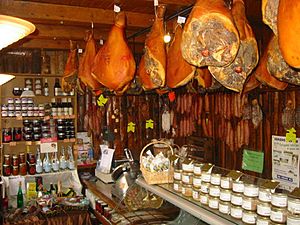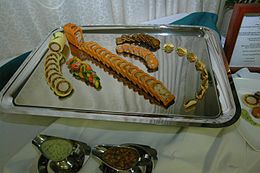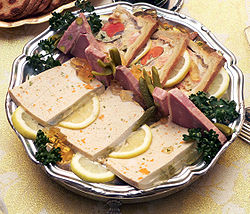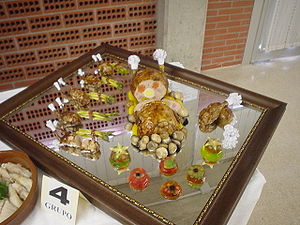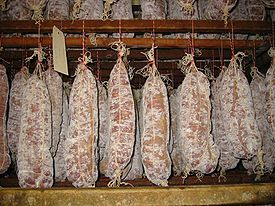- Charcuterie
-
Charcuterie (pronounced /ʃɑrˌkuːtəˈriː/, /ʃɑrˈkuːtəri/; French: [ʃaʁkytʁi], from chair 'flesh' and cuit 'cooked') is the branch of cooking devoted to prepared meat products such as bacon, ham, sausage, terrines, galantines, pâtés, and confit, primarily from pork.[1] Charcuterie is part of the garde manger chef's repertoire. Originally intended as a way to preserve meats before the advent of refrigeration, they are prepared today for their flavors derived from the preservation processes.[2]
Contents
History
In the first century AD Strabo recorded the import of salted meats from Gaul[3] and The Romans may be the first to have regulated the trade of charcuterie as they wrote laws regulating the proper production of pork joints; but the French have also had some influence. In 15th century France, local guilds regulated tradesmen in the food production industry in each city. The guilds that produced charcuterie were those of the charcutiers. The members of this guild produced a traditional range of cooked or salted and dried meats, which varied, sometimes distinctively, from region to region. The only "raw" meat the charcutiers were allowed to sell was unrendered lard. The charcutier prepared numerous items including pâtés, rillettes, sausages, bacon, trotters, and head cheese (brawn). These preservation methods ensured that meats would have a longer shelf-life.[2]
Products created with forcemeats
Main article: ForcemeatForcemeat is a mixture of ground, lean meat emulsified with fat. The emulsification can be accomplished by grinding, sieving, or pureeing the ingredients. The emulsification may either be smooth or coarse in texture, depending on the desired consistency of the final product. Forcemeats are used in the production of numerous items found in charcuterie. Proteins commonly used in the production of forcemeats include pork, fish (pike, trout, or salmon), seafood, game meats (venison, boar, or rabbit), poultry, game birds, veal, and pork livers. Pork fatback is often used for the fat portion of forcemeat as it has a somewhat neutral flavor.[4]
In American usage, there are four basic styles of forcemeat. Straight forcemeats are produced by progressively grinding equal parts pork and pork fat with a third dominant meat which can be pork or another meat. The proteins are cubed and then seasoned, cured, rested, ground and then placed into desired vessel.[4] Country-style forcemeats are a combination of pork, pork fat, often with the addition of pork liver and garnish ingredients. The finished product has a coarse texture.[4] The third style is gratin which has a portion of the main protein browned; the French term gratin connotes a "grated" product that is browned.[4] The final style is mousseline which are very light in texture utilizing lean cuts of meat usually from veal, poultry, fish, or shellfish. The resulting texture comes from the addition of eggs and cream to this forcemeat.[4]
Sausage
Its name derived through French from the Latin sal, "salt", sausage-making is a technique that involves placing ground or chopped meats along with salt into a tube. The tubes can vary, but the more common animal-derived tubes include sheep, hog, or cattle intestinal linings. Additionally, animal stomachs and bladders, as well as inedible casings produced from collagen, plant cellulose or paper are used. Inedible casings are primarily used to shape, store, and age the sausage.[5] There are two main variants of sausage, fresh and cooked. Fresh sausages involve the production of raw meats placed into casings to be cooked at a later time, whereas cooked sausages are heated during production and are ready to eat at the end of production.[6]
Emulsified sausage
Emulsified sausages are cooked sausages with a very fine texture, using the combination of pork, beef, or poultry with fat, salt, nitrate, flavorings, and water. These items are emulsified at high speed in a food processor or blender. During this process the salt dissolves the muscle proteins, which helps to suspend the fat molecules. Temperature is an important part of the process: if the temperature rises above 60 degrees for pork or 70 degrees for beef, the emulsion will not hold and fat will leak from the sausage during the cooking process.[6]
Pâté, terrine, galantine, roulade
Pâté and terrines are often cooked in a pastry crust or a earthenware container. Both the earthenware container and the dish itself are called a terrine. Pâté and terrine are very similar: the term pâté often suggests a finer-textured forcemeat utilizing liver, while terrines are more often made of a coarser forcemeat. The meats are chopped or ground, along with heavy seasoning, which may include fat and other proteins. The seasoning is important for pâté and terrine as they will generally be served cold, which mutes the flavors.[7]
The mixture is placed into a lined mold, covered, and cooked in a water bath to control the temperature, which will keep the forcemeat from separating as the water bath slows the heating process of the terrine. Pâté and terrine are generally cooked to 160 degrees, while terrine made of foie gras are generally cooked to an internal temperature of 120 degrees. After the proper temperature is reached the terrine is removed from the oven and placed into a cooling unit topped with a weight to compact the contents of the terrine. Then it is allowed to rest for several days to allow the flavors to blend.[7]
Galantine is a chilled production of poultry created after the French Revolution by the chef to the Marquis de Brancas. The term galant connotes urbane sophistication. Other origins are suggested: the older French word for chicken géline or galine or the word gelatin. Sources suggest that the spelling of gelatin transformed into the words galentyne, galyntyne, galandyne, and galendine.
The galantine is prepared by skinning and de-boning a chicken or other poultry. The skin is laid flat, with the pounded breast laid on top. A forcemeat is then placed on top of the pounded breast. The galantine is then rolled with the ends of the breast meeting one another. The galantine is then wrapped in cheesecloth and poached in poultry stock until the proper internal temperature is reached.[8]
Roulade is similar to a galantine. There are two major differences, the first difference being that instead of rolling the poultry evenly for the ends of the breasts to meet, the bird is rolled into a pinwheel shape. The second difference is that when the roulade is cooled it is chilled after it has been removed from the poaching liquid.[8]
Salt-cured and brined products
Main article: Curing (food preservation)Salt serves four main purposes in the preservation of food in the charcuterie kitchen. The first is inducing osmosis: this process involves the movement of water outside of the membranes of the cells, which in turn reabsorb the salted water back into the cell; this process assists in the destruction of harmful pathogens. The second is dehydration, which means that the salt pulls excess water from the protein, which aids in the shelf-life of the protein as there is less moisture present for bacteria to thrive in. Fermentation is the third, in which salt assists in halting the fermentation process in meat which would otherwise completely break it down. Finally, salt assists in denaturing proteins, which in essence means that the structure of the proteins is effectively shifted, similar to the effects of cooking.[9]
Before the discovery of nitrates and nitrites by German chemists around 1900, curing was done with unrefined salt and saltpeter. As saltpeter gives inconsistent results, and has been outlawed in the United States for culinary uses since 1975, nitrate and nitrates (in the form of sodium nitrite and sodium nitrate) have increased in popularity for their consistent results. Nitrates take a considerably longer period of time to break down in cured foods than nitrites; because of this, nitrates are the preferred curing salts for lengthy curing and drying periods. Nitrites are often used in foods that require a shorter curing time and are used for any item that will be fully cooked.[10] Eventually a portion of the nitrates will break down into nitrites.[11]
Nitrite has multiple purposes in the curing process. One purpose is flavor, the nitrites giving a sharp, piquant flavor to the meat. Second, the nitrites react with substances in the meat to produce nitric oxide. Nitric oxide prevents iron from breaking down the fat in the meat, thus halting rancidity. The binding also creates the characteristic reddish color found in most cured meats. Finally the nitrite inhibits the growth of botulism-causing organisms that would ordinarily thrive in the oxygen-deprived environment in the sausage casing. German scientists originally named botulism poisoning Wurstvergiftung or "sausage poisoning". The term botulism derives its name from the Latin term for sausage.[12]
Eating cured meat products has been linked to a small increase in gastric cancer[13] as well as chronic obstructive pulmonary disease.[14] The negative effects are presumed to be caused by nitrates and nitrites, as well as nitrosamines which are formed by nitrites reacting with meat. These risks are generally regarded as minimal, and regulations in the United States limit residual nitrates and nitrites to 200 parts per million (0.02%) as a precautionary measure.[12]
Curing salt blends
There are two main types of curing salt mixture used by the charcutier. The first is known by multiple names, including "tinted cure mix", "pink cure", "prague powder", or "insta-cure #1". The mixture is 94 percent sodium chloride and 6 percent sodium nitrite. When used, the recommended amount is a ratio of 4oz/113g for each 100 lb/45.36 kg of meat or .25 percent of the total weight of the meat. This blend is colored bright pink to keep the charcutier from confusing the mixture with regular salt.[15]
The second curing salt blend is called "prague powder II" or "insta-cure #2". Also colored pink to differentiate it from table salt, this blend is produced from salt and sodium nitrate. This mixture is used for dry sausages that require a longer drying period which requires the presence of nitrate.[15]
Seasoning and flavoring agents
Sweeteners and other flavoring agents are necessary in the production of many cured products due to the harsh flavors of the curing salts. A number of sweeteners can be used in curing foods, including dextrose, sugar, corn syrup, honey, and maple syrup. Dextrose is seen often in cured meats as it not only mellows the harshness, but it also increases the moisture content of the cured product while not adding a sweet flavor to the cured meat. The sweeteners also assist in stabilizing the colors in meats and it also helps the fermentation process by giving a nutrient to the bacteria.[16]
Numerous spices and herbs are used in the curing process to assist with the flavor of the final product. The sweet spices regularly used include cinnamon, allspice, nutmeg, mace, and cardamom. Other flavoring agents may include dried and fresh chilies, wine, fruit juice, or vinegar.[16]
Fermented sausage
Fermented sausages are created by salting chopped or ground meat to remove moisture, while allowing beneficial bacteria to break down mild flavored proteins into highly aromatic and flavorful molecules. Bacteria, including Lactobacilli and Leuconostoc, break down these proteins and produce lactic acid which not only affects the flavor of the sausage, but also lowers the pH from 6 to 4.5-5, preventing the growth of bacteria that could spoil the sausage. These effects are magnified during the drying process, as the salt and acidity are concentrated as moisture is extracted.[17]
The ingredients found in a fermented sausage include meat, fat, bacterial culture, salt, spices, sugar and nitrate. Nitrate is added to fermented sausages to prevent the formation of botulism-causing bacteria. Sugar is added to aid the bacterial production of lactic acid during the 18-hour to three-day fermentation process; the fermentation time depends on the temperature at which the sausage is stored: the lower the temperature, the longer the required fermentation period. A white mold and yeast normally adheres to the outside of the sausage during the drying process. This mold adds to the flavor of the sausage and aids in preventing harmful bacteria from attaching to the sausage.[17]
There are two main types of fermented sausage. The first is the dry, salted, spiced sausages found in the warmer climates of the Mediterranean, in countries such as Italy, Spain, and Portugal. Since these sausages contain 25-35% water and more than 4% salt, they may be stored at room temperature. The sausages of northern Europe usually contain less salt (around 3%) and 40-50% water, and as such do not dry well in the humid climate of countries like Germany.[17]
Terminology
The French word for a person who prepares charcuterie is charcutier, generally translated into English as "pork butcher." This has led to the mistaken belief that charcuterie can only involve pork. The Food Lover's Companion, however, says that "it refers to the products, particularly (but not limited to) pork specialties such as pâtés, rillettes, galantines, crépinettes, etc., which are made and sold in a delicatessen-style shop, also called a charcuterie." The 1961 edition of Larousse Gastronomique defines it as: "The art of preparing various meats, in particular pork, in order to present them in the most diverse ways."
See also
- Cold cut
- Salumi
Notes
- ^ Ruhlman, 18.; The Culinary Institute of America, 3.
- ^ a b Ruhlman, 19.
- ^ Jane Grigson Charcuterie and French Pork Cookery
- ^ a b c d e The Culinary Institute of America, 299.
- ^ McGee, 169-170.
- ^ a b McGee, 170.
- ^ a b McGee, 172.
- ^ a b The Culinary Institute of America, 317-318.
- ^ The Culinary Institute of America, 190-191.
- ^ The Culinary Institute of America, 191.
- ^ McGee, 173
- ^ a b McGee, 174.
- ^ Jakszyn P, Gonzalez CA. Nitrosamine and related food intake and gastric and oesophageal cancer risk: a systematic review of the epidemiological evidence. World J Gastroenterol. 2006 Jul 21;12(27):4296-303. PubMed full text
- ^ http://news.bbc.co.uk/2/hi/health/6560121.stm
- ^ a b The Culinary Institute of America, 192.
- ^ a b The Culinary Institute of America, 193.
- ^ a b c McGee, 176.
References
- McGee, Harold. On Food and Cooking: The Science and Lore of the Kitchen. New York: Simon and Schuster, 2004. ISBN 0-684-80001-2.
- Ruhlman, Michael and Polcyn, Brian. Charcuterie: The Craft of Salting, Smoking and Curing. New York: W.W Norton & Company, 2008. ISBN 978-0-393-05829-1
- The Culinary Institute of America. Garde Manger: The Art and Craft of the Cold Kitchen. 3rd ed. Hoboken, NJ: John Wiley & Sons, 2008. ISBN 978-0-470-05590-8
External links
- Istituto Valorizzazione Salumi Italiani, PGI Consortium
- Salumi Casalinghi - in Italian
- Salumi from Life in Italy.com
- Salumi -- Italian Cold Cuts from About.com
Categories:- Charcuterie
- Salumi
- Garde manger
- Meat
- Pork
- French words and phrases
- Restaurant terminology
- Cooking
- Guilds
- Cold cut
- Italian cuisine
- Dried meat
Wikimedia Foundation. 2010.

